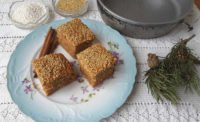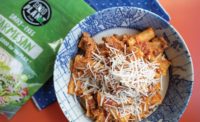2019 Predictions: Starches & Fibers
Starch and Fiber Update: New Approaches to Fundamental Carbs
The demand for clean-label ingredients has opened even more avenues for starches

Advanced milling technology allows for artisanal flours such as from barley to act as 1:1 replacements for wheat flour in certain formulations.
PHOTO COURTESY OF: Alberta Barley (WWW.ALBERTABARLEY.COM)
Starches are the most predominant and versatile class of food ingredient in the food manufacturing supply chain. Their predominance can be attributed to them being abundant, versatile, biodegradable, nutritious, and flavorful, not to mention inexpensive.
Providing structure, flavor, color, and other functions in formulations, as well as nutrients, vitamins, minerals, and healthful phytochemicals for the body, they also are at the fulcrum of most food trends, directly and indirectly. One current and growing trend, the demand for clean-label ingredients, has opened even more avenues for these workhorses.
This trend has, in turn, driven growers, millers, and suppliers to seek out emerging sources and re-examine traditional sources of starches and fibers that might be in the supply chain but are underutilized. And, of course, many of these starches also are sources of functional fibers.
While most starches and fibers in food production have been largely derived from cereals, the double-punch of the allergen/gluten-free and non-GMO trends led to a surge in the use of already mainstreamed starch ingredients from roots and tubers (think: tapioca and potato starches). There also has been a sudden growth in the use of starches derived from legumes, rhizomes, seeds, and even green fruit. And starch and flour sources truly unique to the West—such as those derived from benne (heirloom sesame), peanuts, green bananas, jackfruit seeds, and mango seeds—are entering the market after years of traditional use in Africa and Asia.
Root and tuber crops integral to the diets of people in tropical regions are rich in starch and fiber.
For example, chicory has become a leading source of inulin fiber, and cassava and sweet potato are rapidly growing in popularity as starch sources. This is because they show a wider range of properties than cereal sources that were not as versatile yet had become ubiquitous in the food supply because of functionality provided by chemical modification.
However, the term “modified” as an adjective to describe starches has become unfriendly to consumers, and the quest is on for starches with greater functionality than that of cereal starches. Modified starches from other crops are becoming more important.
Starches from potatoes, rice, and tapioca have been on a steady climb, as they are favored for clean taste, high functionality, and hypoallergenicity. But starches from peas, lentils, and cassava are increasingly being used in foods that are canned, retort-packed, or frozen because of their enhanced thermal stability and decreased extent of setback.
The Heat Is On
Formulators are discovering new and unique functional properties of starches from quinoa, oat, barley, potato, and seeds of tropical plants, using these ingredients as stabilizers or emulsifiers to improve the quality of a range of food products. To maintain their clean-label status, some of the starches call for different treatments in their manufacture.
Annealing and heat-moisture treatment (HMT) are hydrothermal treatments that modify the physiochemical properties of starch without destroying the integrity of their granular structure. Annealed starches are ideal for noodles; they provide the right chewiness and resistance to overcooking without causing swelling. These treatments help allow naturally gluten-free native (non-chemically modified) starches to perform in formulations where gluten typically would be needed for structure and stability.
The heat and moisture modifications decrease starch swelling, solubility, and peak viscosity to give these starches excellent freeze-thaw stability and organoleptic properties that are desired in such products as frozen pie fillings or thickened soups and stews.
An added advantage is that, for some starch and fiber sources, heat-moisture treatment boosts the health profile of the ingredient. For example, heat-treated cassava starch becomes resistant starch through retrogradation, making it ideal for infant and toddler foods as a safe source of fiber.
Emerging Functionality
Novel starch-based emulsifiers are gaining traction as a solution for long-term stability of oil/water-based foods. Product formulators are challenged to produce clean-label foods that are not only nutritious and of good quality, but also have extended shelflife, robust structure, and stability during storage and handling—without the use of chemical emulsifiers.
Gluten-free rolls, muffins, and other bakery products with an open and soft but not doughy crumb grain are now possible with native starches, starchy flours, functional starches, modified starches, and hydrocolloids. The key is understanding the behavior of each starch during the various steps of the food making process and selecting the appropriate starch for the desired functionality.
Rice starch and rice flour are used in tandem with starches and flours from potato, corn, and tapioca to replicate the original food’s texture and quality in gluten-free versions. Mixtures of starches can reproduce the various and unique functional properties of gluten, including dough elasticity and extended shelf life, as well as moist, cohesive, and tender crumb textures.
Tapioca starch is gaining a greater foothold across myriad food applications by leveraging its inherent properties as a clean-label alternative to chemically modified starches. Tapioca maltodextrin produced from non-GM tapioca using an enzymatic process is allergen free and Cronobacter-free, and it is suitable as a source of calories in infant formulas.
Quinoa, popular across the globe because of its attractive nutritional profile, is showing great potential in the starch aisle because starch makes up about 70% of quinoa. Quinoa starch granules are small (∼1–3 μm), with relatively lower amylose content than that of grains.
Quinoa amylopectin has significant amounts of short chains and super-long chains. Together, these unique features are gaining ground for quinoa starch in gluten-free noodles, extruded snacks, and even milk analogs.
Tamarind starch, isolated from tamarind kernels left over from pulp processing, has physicochemical, rheological, and morphological properties similar to corn starch. Its amylose content is lower than that of corn starch, but its light transmittance, solubility, and swelling power mimic those of corn starch and mung bean starch, another popular legume source. The rheology of tamarind kernel starches positions it to be a low-cost replacement for corn starch, as large numbers of seeds are presently discarded as waste.
Food processors require starches and fibers to be stable in acidic, high-heat, cold-temperature, and high-shear conditions, while product formulators rely on starches to impart viscosity, stability, creaminess, texture, binding properties, cohesiveness, and distinctive mouthfeel.
Consumers want these ingredients to be as close as possible to their existence in nature. Formulators can take advantage of the expanding palette of sources for starches and fibers by teaming up with suppliers to test their formulations with starches of various botanical origins. Thus, they can identify which starch, flour, or fiber variety will retain molecular integrity and provide the desired functionality.
Originally appeared in the December, 2018 issue of Prepared Foods as Starch and Fiber Update.
Looking for a reprint of this article?
From high-res PDFs to custom plaques, order your copy today!






